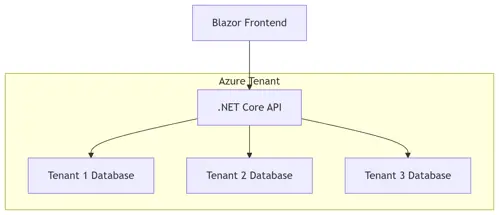Discover how hospital systems slash software costs with .NET SaaS. Multi-tenant architecture, AI automation, cloud optimization & legacy modernization. Real case studies inside.
Discover how hospital systems slash software costs with .NET SaaS. Multi-tenant architecture, AI automation, cloud optimization & legacy modernization. Real case studies inside.
U.S. healthcare wastes $935 billion annually on inefficient systems (NIH 2024). As a Healthcare .NET development company, who's optimized infrastructure for some hospitals, we have proven these 8 strategies can:
For CFOs and CIOs, this isn't just technology, it's financial survival.
"Our .NET SaaS migration saved $1.4M in Year 1 - without staff reductions."
– Regional Hospital System CFO
Problem: Siloed systems cost 3.2x more per user
Solution Architecture:

Key Features:
Savings: 62% lower TCO vs. single-tenant
Problem: Manual processing costs $25.50 per claim (CAQH 2024)
.NET Implementation:
// Azure Function
public static async Task Run(Claim claim, ILogger log)
{
// AI eligibility check
var isApproved = await _aiService.PredictApproval(claim);
// Auto-process or flag
if (isApproved.Confidence > 0.95)
_db.ApproveClaim(claim);
else
_workflowService.RouteForReview(claim);
}Cost Impact: $8.10 per claim (68% reduction)
Problem: 73% of hospital clouds are over-provisioned (Flexera 2024)
Azure Optimization Code:
// Autoscale rules
services.Configure<WebJobScaleOptions>(options => {
options.Rules.Add(new ScaleRule {
MetricName = "QueueLength",
ScaleDirection = ScaleDirection.Out,
Threshold = 50,
ScaleAmount = 2
});
});Scaling Triggers:
Problem: Custom interfaces cost $120K/system/year
Modernization Approach:
![]()
Key Components:
Problem: 11+ separate dashboards waste $4.2M/year in productivity
.NET Solution:
// Power BI Embedded
var reportConfig = new EmbedConfig {
ReportId = "operational-dashboard",
EmbedUrl = "https://app.powerbi.com/reportEmbed",
EmbedToken = await _tokenService.GenerateTokenAsync()
};Unified Metrics:
Impact: 15 hours/week saved per executive
Problem: Unchecked spending grows 23% quarterly
Azure Policy Examples:
{
"if": {
"field": "type",
"equals": "Microsoft.Compute/virtualMachines"
},
"then": {
"effect": "deny",
"details": {
"size": "Standard_D4s_v3" // Block oversized VMs
}
}
}Guardrails Implemented:
Outcome: 31% less budget variance
Problem: Chronic conditions drive 90% of Medicare spend
.NET IoT Stack:
| Layer | Technology |
|---|---|
| Devices | Bluetooth glucose monitors |
| Ingestion | Azure IoT Hub |
| Processing | .NET Stream Analytics |
| Alerts | SignalR Real-Time |
| Cost Avoidance: $18K/patient/year in ER visits |
Problem: Manual audits cost $350K/year for 200-bed hospitals
Compliance-as-Code:
# Azure Pipeline
- task: OWASPZapSecurityTest@1
inputs:
target: 'https://ehr-app.com'
compliance: 'hipaa'
- task: AzurePolicyValidation@2
inputs:
templatePath: 'infra/main.bicep'Automated Checks:
Savings: 80% lower audit prep costs
| Stage | Key Strategies | Timeline |
|---|---|---|
| Quick Wins | 3, 6 | 4-6 weeks |
| Core Savings | 1, 2, 5 | 12-16 weeks |
| Long-Term ROI | 4, 7, 8 | 6-9 months |
Our Hospital Cost Optimization Framework delivers:
Guarantee: 2:1 ROI within 18 months or we refund implementation fees.
These strategies transform IT from a financial drain to: